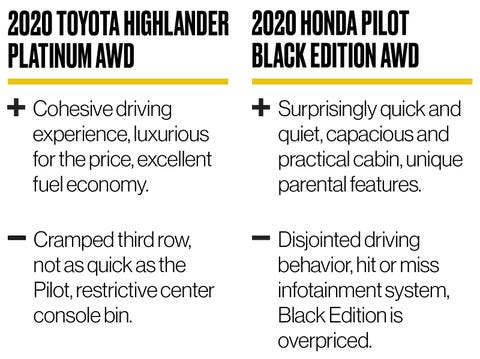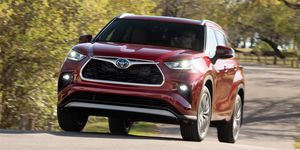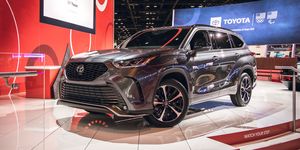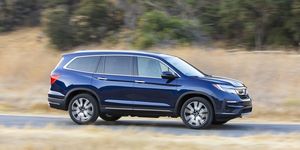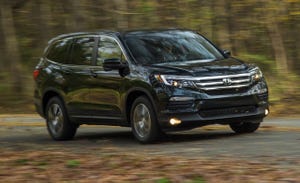“Would You Rather” is a game in which players challenge one another with a choice of hypothetical questions. For example, would you rather have as your only form of transportation a llama or a pretty tame ostrich? Of course, car enthusiasts play it a little differently, and we found ourselves asking “This or that?” while comparing the top-of-the-line versions of the Honda Pilot and Toyota Highlander.
The Pilot and Highlander we gathered together have a lot in common. Both are mid-size three-row crossovers with room for seven, and each has a V-6 powertrain and all-wheel drive. Our examples both came with prices just north of $50,000. Despite these many similarities, Honda and Toyota approached design very differently. The Pilot has a rugged aesthetic that attempts to hide its minivan roots (with mixed results), and its spacious interior prioritizes practicality over vanity. The Highlander, on the other hand, has streamlined bodywork and a flashier cabin that moves it toward the luxury end of the spectrum. That dichotomy begs the question: Would you rather look like you’re going hiking or headed to dinner?
The Matchup
The current Pilot arrived for 2016 and is a close cousin to the Honda Odyssey minivan and Ridgeline pickup. Last year, the Pilot underwent a mid-cycle refresh that includes tougher-looking styling, and for 2020 it adds a few more features and a new range-topping Black Edition. To paraphrase Henry Ford, “You can have any color you want as long as it’s Crystal Black Pearl.” The monochromatic exterior treatment extends to the standard 20-inch wheels and nearly all of the exterior trim. Inside, it has black leather upholstery, embossed Black Edition logos, and a smattering of red accents. It comes equipped with all the standard equipment found on the Elite model including all-wheel drive, heated and ventilated front seats, heated second-row captain’s chairs, a panoramic sunroof, and wireless charging. Our Pilot stickered for $50,840 without any additional options, which represents a $1500 upcharge over the Elite model.
Toyota redesigned the Highlander from the ground up for 2020. Now in its fourth generation, the updated three-row staple is now built on the company’s TNGA-K platform that also underpins the Toyota Camry and RAV4. Along with a more modern exterior and interior, the Highlander also gets enhanced driver-assistance technology and an updated infotainment system. Our top-of-the-line Platinum trim tester has a silver-painted front bumper and rear fascia plus unique 20-inch wheels to distinguish it from the lesser Highlanders. It also comes standard with a 12.3-inch touchscreen, a camera-based rearview mirror, a head-up display, heated and ventilated front seats, heated second-row captain’s chairs, and a panoramic sunroof. The front-drive Highlander Platinum starts at $49,920. All-wheel drive is an extra $1525 and a combined $1192 for its special light-blue Moon Dust paint, carpeted floor mats, roof-mounted crossbars, and universal tablet holders that put its as-tested price at $51,112.
On the Road
Both SUVs have the power to charge down a freeway on-ramp or make a quick pass on a two-lane road. Toyota fits a 295-hp 3.5-liter V-6 and an eight-speed automatic transmission into the Highlander, and they work smoothly and quietly. In our testing, the 4504-pound Highlander arrived to 60 mph in 6.7 seconds and squirted from 50 to 70 mph in 5.3 ticks.
We liked the Highlander’s quick throttle response and responsive gearchanges, but the Pilot is the quicker of the two. It’s down five horses to the Toyota, but the Honda’s 290-hp 3.5-liter V-6 has 177 fewer pounds to lug around. The result is a 6.4-second run to 60 mph. Paired with a nine-speed automatic, the Pilot’s V-6 slips into the background when cruising and registered a luxurious 66 decibels at 70 mph, to the Highlander’s 69-decibel reading. Still, we prefer the way the Highlander responds to prods of the accelerator and the transmission’s willingness to quickly adapt to our varied driving behavior.
The Highlander goes down the road with a smooth agility that’s appropriate for a three-row SUV. We briefly drove the Highlander at its launch, and our first impressions hold up after living with it for a couple of weeks. Its steering has a nice heft and is accurate and linear in its motion. The Pilot comes across as overly light in effort and as if it’s withholding information about what the tires are going through.
We also noticed that the Highlander dealt with big impacts through the suspension and structure with more grace than the Pilot. The Toyota’s suspension and sound deadening muted the impacts faster and better than hollow-sounding hits we heard in the Honda.
In corners, the Pilot rolls a bit more. It doesn’t necessarily affect stability but gives you pause when rounding an entrance ramp. The Highlander also outgripped the Pilot, giving a slightly larger measure of security for evasive maneuvers. The Toyota also enjoyed an advantage in braking tests, where it stopped from 70 mph in 167 feet to the Pilot’s 172. We also preferred the Highlander’s firmer brake pedal. The Pilot also suffered from moderate fade during our six successive stops from 70 mph.
Considering how similar the Pilot and the Highlander are, it’s not a surprise that the EPA fuel-economy estimates for the all-wheel-drive Highlander and Pilot are very close. The Toyota is rated at 20 mpg city, 27 highway, and 23 combined. The Honda gives up 1 mpg in all three categories. However, we were impressed with how much Honda has improved the Pilot’s automatic stop-start feature, which can now unobtrusively and quickly restart the engine. In our steady 75-mph highway test, the Pilot returned 25 mpg to the Highlander’s 28 mpg.
The Inside View
Perhaps it’s familiarity, but the Pilot’s interior strikes us as functional rather than exciting. As in the best Hondas, there’s plenty of passenger space and no shortage of interior cubby storage. Its front seats are comfortable for all body sizes, and the driver enjoys a commanding view of the road ahead. Honda’s infotainment system includes an 8.0-inch touchscreen with Apple CarPlay, Android Auto, and a Wi-Fi hotspot. We appreciate the physical volume knob and large onscreen icons, but changing the radio station and navigating menus is harder than it should be.
Our Black Edition also boasts features that make parenting easier, including a rear-seat entertainment system and an intercom called CabinTalk that lets front-seat passengers talk to (or reprimand) the back two rows. Getting into the third row is easy because the second-row captain’s chairs move well out of the way. Once you’re in the third row, there’s more room than in the Highlander. In our suitcase test, the Pilot held just as many roller-bag carry-ons as the Toyota behind its third row (four), and it held eight more with all the rear seats folded (38 total).
The Highlander’s interior looks and feels considerably richer than its Honda rival. Our Platinum model had the handsome Harvest Beige leather upholstery and one of the best examples of fake-wood trim that we’ve seen. The instrument panel is dominated by a massive touchscreen that supports Apple CarPlay, Android Auto, and a Wi-Fi hotspot. Below it is a set of HVAC controls and heated seat controls as well as a built-in shelf that’s perfect for storing small items. The center-console bin offers additional storage, but its small opening and wireless charging pad impose size restrictions. While we found the Highlander’s driving position to be more accommodating than the Pilot’s, its cramped third row left us sitting with our knees in our chest.
The Bottom Line
Both the Pilot and the Highlander nail the practicality and people hauling part of the brief—although the Highlander’s third-row seats don’t measure up to the Pilot’s. Next to the Highlander, and despite the refresh, the Pilot feels like the older vehicle. It lacks the upmarket appeal of the Highlander’s interior. If we were shopping for a loaded Pilot, we’d steer clear from the Black Edition and go for the $49,340 Elite trim level instead. The Pilot doesn’t do much wrong, but despite its higher price, the Highlander Platinum seems worth it. It has Lexus-worthy interior design and materials, it’s more refined and quieter as it goes about its business, and we liked driving the Highlander more than the Pilot.
So, there you have the answer to the question: Would you rather buy the priciest Honda Pilot or the fanciest Toyota Highlander? Based on our testing, we’d choose the Toyota. To answer the earlier question, we’d probably go llama.
Source: Reviews - aranddriver.com

